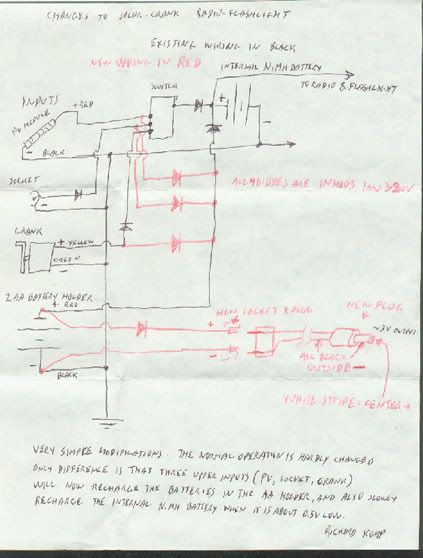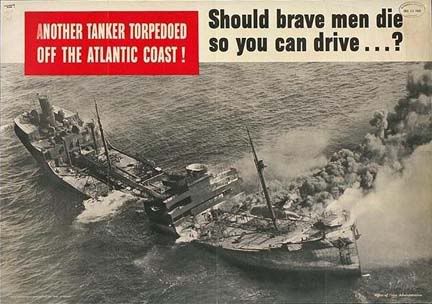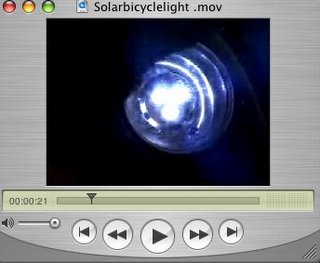1. Solar Product Chain
I want to make a series of steppingstone products to full solar electric power:
solar powered LED light - flashlight, keychain or backpack fob
solar jewelry - rings, bracelets, necklaces, with solar charging brooch and rechargeable battery pack
solar bicycle light (for visibility)
This set of products uses button batteries, CR2016 and CR2032 size and hearing aid batteries, for instance. The simplest system is a solar cell, with a blocking diode, a set or rechargeable batteries, and a single LED
solar/dynamo flashlight/radio and battery charger
The charger works on AA and other dry cell sizes, possibly up to 12 volts. A radio and flashlight are what is recommended in case of emergency and disaster. If the extra set of batteries is rechargeable, the solar/dynamo system can produce electricity day or night by sunlight or muscle power as long as the batteries can carry a charge.
solar car battery charger (one square foot)
12 volt (and multiples)
Every car can become a "hybrid vehicle" by installing an extra battery and a control system to charge from the alternator when the engine's battery is finished. Battery switching, with 12 volt or dry cell or even button batteries is a key concept in the solar transition.
one window solar electric system (four square feet)
12 volt, with AC inverter and possible grid connect
The one window system is 4 square feet of solar collector and should be almost as easy to install as an air conditioner. Open the window, erect the frame, aim it at the sun, attach collector, plug it in, and close the window.
There should be a consistent look and feel to all the products along the product chain and as much inter-operability as possible.
2. Your Southernmost Window
A series of half hour programs for TV, videotape, DVD and other digital media
What you can do with one south-facing window, or how to live within a solar budget, including designs viewers can replicate at home to provide heat, light, ventilation, and/or stimulate ecological growth.
Program 1. What You can See from a Window - one square foot of sunlight, orientation to the sun, design principles, window types, glazing, heat loss, infiltration, insulation, heating ventilating and air conditioning (HVAC), air purification, breathing
Program 2. Every Window in the House - window types take 2, radiation and convection, caulking and weatherstripping, drafts and infiltration, how to chart your airflows, how to use them, window insulation, whole house HVAC
Program 3. The Electric Window - solar electricity/photovoltaic/PV, small battery charger, solar/dynamo flashlight radio, one window systems, permanent emergency capacity, battery switching and your car
Program 4. Hot and Cold Windows - windowbox heaters, passive and active ventilators, advanced airflow usage, active and passive water heating, your northernmost window, a nod towards refrigerators and low heat differential heat pumps
Program 5. The Greenhouse Window - windowsill gardens, bubbling out/bubbling in, heat storage, aquaculture, vermiculture, and ecological housekeeping, the neighborhood
Program 6. Most Windows in Town -what if everybody did it?, the economics of sunlight, systems thinking from community to region to country to world, globalization of solar physics
3. Mister Franklin's Folks
Mister Franklin’s Folks began when a small group of people decided to bring a solar fountain to the local farmers markets, swap meets, and outdoor community events and began to generate public power. Each week, they’d float the solar electric panel and pump the water in a tub and the little fountain would splash and spray. The brighter the sunshine the higher the water would go. Children loved to turn it on and off with their shadows, jumping into and out of the sunlight, making the water dance and themselves laugh. Older kids asked questions and so did some of the adults. “What’s it for?" "How does it work?" "Why are you doing this?" "So what?”
The exhibit was labeled, “Solar Fountain/Wishing Well” and some coins lay at the bottom of the tub. There was a big can labeled “Donations” on the table under the shade of an awning or umbrella where one of Franklin’s Folk sat with a portable computer and a collection of books, pamphlets, leaflets, cards, and stickers. The car, van or truck parked behind them was full of working models and public experiments, product demos and testing equipment. The computer had a wireless connection to the Internet and could print out paper copy or otherwise transfer the information. For a donation.
Each week, from Memorial Day to the week before Thanksgiving, throughout the farmers market season, they’d be there. Each week, they’d set up the solar fountain and present a different demonstration of solar ingenuity and practical power. When they said "Power to the people," they meant it literally.
The Franklin Folk said “Your south-facing window is already a solar collector and we can show you how to use it.” They provided designs and projects that began by caulking and sealing a window and ended with a complete one room HVAC and electrical system for daily and/or emergency use.
They liked the little solar/dynamo radio/flashlights that were around then. “A solar/dynamo and a set of rechargeable batteries is a perpetual source of personal AA electrical power - at least until the batteries wear out. You should have power as long as the sun keeps shining, you can turn the hand crank, and the batteries hold a charge. And when the batteries die, all you have to do is go out and buy some new ones. That is, unless we’ve changed to fuel cells or flywheels by then.”
“If you have a bicycle or exercise equipment, you can probably install a generator device and provide another lifetime supply of AA power from that, too!” They had the plans so you could do it yourself and a bulk buying club so that people could save money on parts and supplies. “Let your kids make their own battery power from sunlight and a little exercise. Power your devices with a walk on the treadmill or while biking on errands.”
They did simple experiments like the one with three boxes of air - three small, sealed, transparent boxes all the same size, each with a thermometer. They set them out in the sun - one box totally transparent, one box's clear sides covered in white insulation board except for the side facing the sun, the third box covered with black insulation board and one side, also, clear to the sun. Two thermometers measured the temperature of the outdoor air, one in the sunlight and another in the shade. The Franklin Folk displayed the results of that day’s solar race with a running total on computer by their table and on the Internet with a mobile uplink.
They called themselves Mister Franklin’s Folks because, like Benjamin Franklin, they believed in ingenuity and thrift. They quoted Poor Richard:
A penny saved is two pence clear. A pin a-day is a groat a year. Save and have.
Every little makes a mickle.
A wise Man will desire no more than what he may get justly, use soberly, distribute cheerfully and leave contentedly.
Spare and have is better than spend and crave.
Like Mr Franklin, they were experimenting with electricity but instead of kites and lightning, they were looking at the sun for energy independence and building the idea of a renewable economy use by use, appliance by appliance, socket by socket, room by room.
One day, one of Mr Franklin's Folk pointed back at their car and said, "This car is now a hybrid vehicle. We modified it to charge an extra battery and can switch that battery with one in the house to run another room or part of the household. Many of us Franklin Folk are reducing our electrical bills considerably. Eventually we want to use the the grid only for back-up and you can too. With the money we save, we'll be able to install enough solar electric panels so we can begin to run the meter backwards and the electric company will have to pay us."
Other days, they had information on how to keep a pantry and food storage. Not only did they teach people how to can and salt and dry foods but they also helped organize buying clubs and bulk purchases in season to save everybody money and help the farmers in the local agricultural system steady their income and cash flow. At the farmers market they displayed maps of all the agricultural resources in the state - farmers markets, pick-your-owns, farm stands, CSAs, community gardens and farms, coops, buying clubs, community kitchens, food pantries and feeding programs. They had composting and worm farming demonstrations, taught the local community, backyard and windowsill gardeners how to lengthen their growing seasons, and encouraged the public planting of fruit trees and berry bushes throughout the city and town.
“Spare and have is better than spend and crave.”
"A wise Man will desire no more than what he may get justly, use soberly, distribute cheerfully and leave contentedly."
"Every little makes a mickle."
"A penny saved is two pence clear. A pin a-day is a groat a year. Save and have."
They quoted Poor Richard's old home truths but put them into an ecological survival context. Each week they offered practical lessons in real thrift or how to save a fortune while saving the environment, the community, and the world.
"Franklin established the oldest working cooperative in the United States, the Contributionship for the Insurance of Houses from Loss Against Fire in 1752. It was called the Hand-in-Hand, after the symbol of four hands grasping four wrists in a form commonly known as a Jacob's Chair. It was their fire mark, a sign they put on the houses they insured so that their volunteer fire department would know which houses it had responsibility for. A volunteer fire department not associated with the Hand-in-Hand would just let the building burn."
"How would Mister Franklin do business these days?" Mister Franklin's Folks asked. "Benjamin Franklin was one of the early researchers into the Gulf Stream. How would he deal with global warming and the ozone hole, let alone local pollution? He invented an odometer to set up postal routes and was the first postmaster general of the United States. What do you think he'd do with the Internet? He published the first political cartoon in North America and refused the job of writing the Declaration of Independence because he would not be edited by anyone but himself.
"Benjamin Franklin was a printer, writer, editor, newspaper, magazine, and book publisher. What do you think he would have done in the modern news environment?"
These were some of the things Mr. Franklin’s Folks brought to their table at the farmer’s market, church social, and neighborhood celebration week after week all that year.







